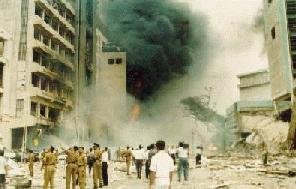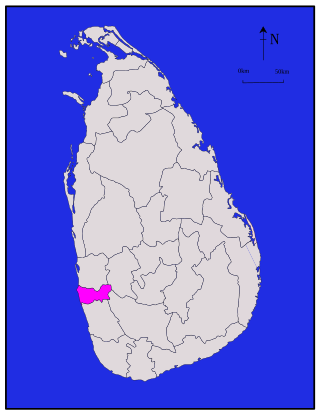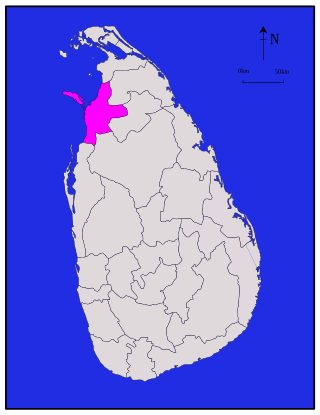Following is a list of bombings in Sri Lanka :
Following is a list of bombings in Sri Lanka :

The Sri Lankan Civil War was a civil war fought in Sri Lanka from 1983 to 2009. Beginning on 23 July 1983, it was an intermittent insurgency against the government by the Velupillai Prabhakaran-led Liberation Tigers of Tamil Eelam. The LTTE fought to create an independent Tamil state called Tamil Eelam in the north-east of the island, due to the continuous discrimination and violent persecution against Sri Lankan Tamils by the Sinhalese-dominated Sri Lanka government.

The Central Bank bombing was one of the deadliest attacks carried out by the Liberation Tigers of Tamil Eelam (LTTE) during the separatist civil war in Sri Lanka between the government and the Tamil Tigers.
The Navaly Church bombing was the 1995 bombing of the Church of Saint Peter and Saint Paul in Navaly in the Jaffna Peninsula by the Sri Lankan Air Force during the Sri Lankan Civil War. It is estimated that at least 147 civilians, who had taken refuge from the fighting inside the church, died as a result of this incident. The victims included men, women and children.
The Nager Kovil school bombing refers to an airstrike that took place on September 22, 1995, when the Sri Lankan Air Force bombed the Nagar Kovil Maha Vidyalayam school in Jaffna, resulting in the death of, by varying accounts, 34-71 Sri Lankan Tamil civilians, primarily schoolchildren and the injury of many more. Sri Lankan Defense Spokesman admitted the incident but claimed that it was a LTTE facility and most of the dead were LTTE cadres. Journalists and human rights organizations reported the imposition of censorship and the airstrike took place about 12 hours after the Government imposed press censorship on reporting military events.

The Vaharai bombing is a disputed event in the Sri Lankan civil war. It occurred on November 7, 2006 when, according to survivors of the incident interviewed by Reuters, the Liberation Tigers of Tamil Eelam fired artillery at Sri Lankan military personnel from near a school where minority Sri Lankan Tamil refugees displaced by the current phase of the Sri Lankan civil war had taken shelter. The Sri Lankan Army returned fire and around 45 civilians were killed. Over 100 were injured and admitted to the local hospitals. However, people who were interviewed by Human Rights Watch claimed that the LTTE did not fire artillery. Further, the rebel LTTE denies firing artillery from close to the school. The incident occurred at around 11.35 a.m close to Kathiraveli, a coastal village in Vaharai peninsula of the Batticaloa district in eastern Sri Lanka.
The Kebithigollewa massacre occurred on 15 June 2006 when 60 civilians were killed by an LTTE claymore attack on a bus. The U.S and the SLMM claimed that LTTE was the perpetrator. However, the LTTE have denied accusations of being involved in the attack
Eelam War I is the name given to the initial phase of the armed conflict between the government of Sri Lanka and the LTTE.
The Tamil Eelam Air Force or Sky Tigers was the air-wing of the Liberation Tigers of Tamil Eelam (LTTE), who used it against the Government of Sri Lanka. They also called themselves the Tamileelam Air Force (TAF). Though the existence of the Sky Tigers had been the subject of speculation for many years, the existence of the wing was only revealed after an attack in March 2007, during Eelam War IV.

Eelam War IV is the name given to the fourth phase of armed conflict between the Sri Lankan military and the separatist Liberation Tigers of Tamil Eelam (LTTE). Renewed hostilities began on the 26 July 2006, when Sri Lanka Air Force fighter jets bombed several LTTE camps around Mavil Aru anicut. The government's casus belli was that the LTTE had cut off the water supply to surrounding paddy fields in the area. Shutting down the sluice gates of the Mavil Aru on July 21 depriving the water to over 15,000 people - Sinhalese and Muslim settlers under Sri Lankan state-sponsored colonisation schemes in Trincomalee district. They were denied of water for drinking and also cultivating over 30,000 acres of paddy and other crops. The fighting resumed after a four-year ceasefire between the Government of Sri Lanka (GoSL) and LTTE. Continued fighting led to several territorial gains for the Sri Lankan Army, including the capture of Sampur, Vakarai and other parts of the east. The war took on an added dimension when the LTTE Air Tigers bombed Katunayake airbase on March 26, 2007, the first rebel air attack without external assistance in history.
The 2008 Sri Lanka roadside bombings were two separate roadside bombings that killed 32 people and injured 62 others on January 16, 2008. The first roadside bomb was aimed towards a civilian bus, with gunmen shooting at fleeing survivors and then retreating into the bush, killing farmers who encountered them. The second roadside bomb was aimed towards a military vehicle, injuring three soldiers. The Sri Lankan Government has blamed the Liberation Tigers of Tamil Eelam (LTTE) for the attacks.

The 2008 Piliyandala bombing was a bombing of a commuter bus carried out on April 25, 2008 in Piliyandala, Sri Lanka, a suburb of Colombo. The bombing killed 26 and injured at least 64, and was the first major attack against civilians on the island since the April 6 Weliveriya bombing that killed Highways Minister Jeyaraj Fernandopulle and national athletics coach Lakshman de Alwis. It was also the deadliest bus bombing since the January 16 attack on a civilian bus at Buttala.

The Madhu School bus bombing, also known as Thadchanamadhu claymore attack, was the bombing of a school bus carried out on January 29, 2008 in rebel LTTE controlled area in Thadchanamadhu in Mannar, Northern province of Sri Lanka. The bombing killed 17 Tamils, including 11 school children, and injured at least 14 more people. The LTTE and NESHOR accused the Sri Lankan Army ’s deep penetration unit for the attack but the Army denied the allegations. This attack was the second attack on a civilian bus in the month of January in Sri Lanka

The 2008 Dehiwala train bombing was a bombing of a commuter train, running from Colombo to Panadura on May 26, 2008, in Dehiwala, Sri Lanka, a suburb of Colombo. The bombing killed 9 people and injured at least 67. The Sri Lankan military blames the LTTE for the attack.

Madhu church shelling or Madhu church massacre is the name for the shelling of the Shrine of Our Lady of Madhu in Sri Lanka during the Sri Lankan civil war on November 20, 1999. The shelling resulted in the deaths of approximately 40 minority Sri Lankan Tamil civilians, including children, and more than 60 non-fatal injuries. The exact cause and nature of the event is disputed between the rebel Liberation Tigers of Tamil Eelam and the Sri Lankan government. According to Bishop Rayappu Joseph, the attack was carried out by the LTTE. The church is a Roman Catholic Marian shrine in Mannar district of Sri Lanka. With a history of over 400 years, this shrine acts as a center for pilgrimage and worship for Sri Lankan Catholics and others. The site is considered as the holiest Catholic shrine in the island.
The following lists notable events that took place during 2009 in Sri Lanka.
The Aluth Oya massacre was the massacre of 127 Sinhalese civilians, including children and women, by the cadres of Liberation Tigers of Tamil Eelam organization on April 17, 1987, near the village of Aluth Oya, on the Habarana Trincomalee road in North Central Province of Sri Lanka. This massacre is considered one of the most notorious and devastating atrocities committed by the LTTE during the history of the Sri Lankan Civil War.